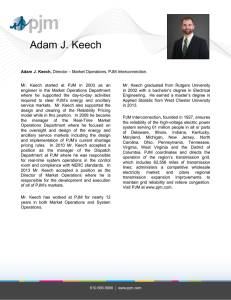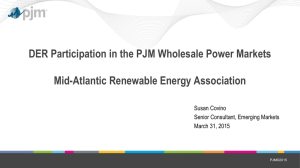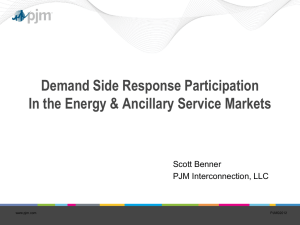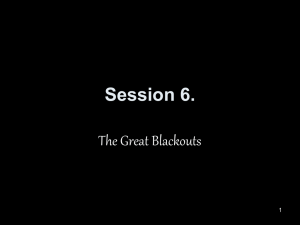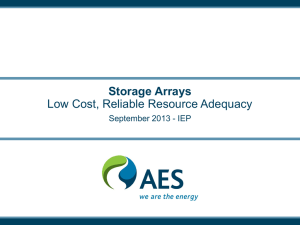PJM Capacity, Demand vs. Efficiency, Coal
advertisement
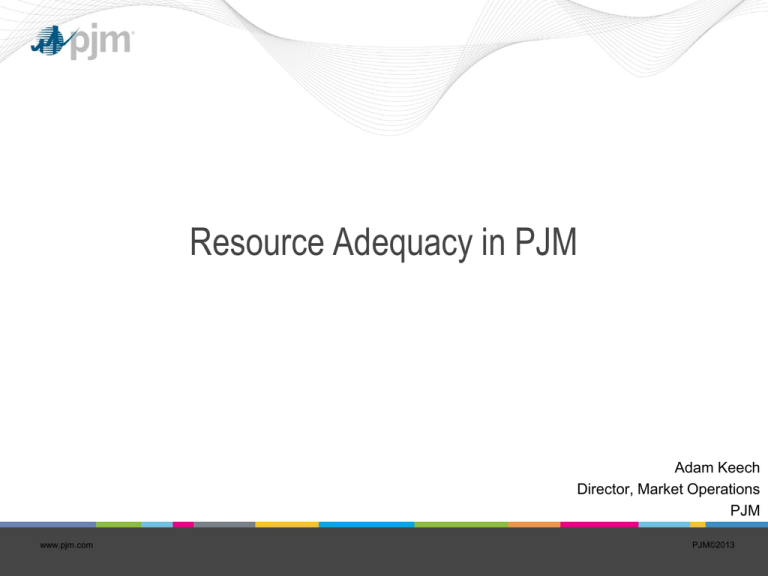
Resource Adequacy in PJM Adam Keech Director, Market Operations PJM www.pjm.com PJM©2013 My Background Adam Keech – Worked at PJM for over 10 yrs • 8+ years in Market Operations – Manager, Real-Time Market Operations – Director, Market Operations • 2+ years in System Operations – Director, Dispatch – Education • MS Electrical Engineering from Rutgers University • MS Applied Statistics from West Chester University www.pjm.com 2 PJM©2013 PJM as Part of the Eastern Interconnection KEY STATISTICS PJM member companies 800+ millions of people served 60 peak load in megawatts 163,848 MWs of generating capacity 185,600 miles of transmission lines 59,750 GWh of annual energy 832,331 generation sources 1,365 square miles of territory 214,000 area served 13 states + DC externally facing tie lines 142 • 26% of generation in Eastern Interconnection • 28% of load in Eastern Interconnection • 19% of transmission assets in Eastern Interconnection 21% of U.S. GDP produced in PJM As of 9/7/2012 *Map is missing EKPC zone which joined June 1, 2013 www.pjm.com 3 PJM©2013 PJM Evolution www.pjm.com 4 PJM©2013 PJM Responsibilities Regional Reliability www.pjm.com Wholesale Electric Markets 5 Transmission Planning PJM©2013 PJM Capacity Market PJM Capacity Market Reliability Pricing Model (RPM) Fixed Resource Requirement Alternative (FRR) (opt-out of RPM) PJM secures capacity on behalf of LSEs to satisfy load obligations not satisfied through self-supply. LSE secures capacity to satisfy their load obligation. PJM Capacity Market is designed to ensure adequate availability of resources that can be called upon to ensure the reliability of the electric grid. www.pjm.com 6 PJM©2013 What is the RPM? • Reliability Pricing Model (RPM) is PJM’s resource adequacy construct • RPM is part of an integrated approach to ensuring long-term resource adequacy and competitively priced delivered energy • RPM aligns the price paid for capacity with overall system reliability requirements • RPM includes pricing to recognize and quantify the locational value of capacity (effective 2007/2008 Delivery Year) and the operational value of capacity (effective 2014/15 Delivery Year) • RPM provides forward investment signals www.pjm.com 7 PJM©2013 Capacity vs. Energy Energy • Generation of electrical power over a period of time • Energy revenues paid to resource based on participation in PJM’s Day-Ahead & Real-Time Energy Markets • Hourly product Capacity • A commitment of a resource to provide energy during PJM emergency under the capped energy price. • Capacity revenues paid to committed resource whether or not energy is produced by resource. • Daily product Capacity, energy & ancillary services revenues are expected, in the long term, to meet the fixed and variable costs of generation resources to ensure that adequate generation is maintained for reliability of the electric grid. www.pjm.com 8 PJM©2013 RPM Structure 3 Years 20 months May 10 months Sept May be scheduled at any time prior to DY 3 months July Feb. EFORd Fixed Interruptible Load for Reliability (ILR) June 1 May 31 Delivery Year (Only effective prior to 12/13 DY) *Certification deadline April 1 for 11/12 DY Base Residual Auction Conditional Incremental Auction March* First Incremental Auction Second Incremental Auction Third Incremental Auction (Effective 12/13 DY) Ongoing Bilateral Market www.pjm.com 9 PJM©2013 Price = UCAP Price ($/MW-day) Illustrative Example of a VRR Curve (a) 1.5 Net Cone Effective 12/13 DY: Target Level = Reliability Requirement –Short Term Resource Procurement Target (b) Net Cone 0.2 Net Cone (c) (IRM – 3%) IRM (IRM + 1%) (IRM + 5%) Quantity = UCAP MW A VRR Curve is defined for the PJM Region. Individual VRR Curves are defined for each Constrained LDA. www.pjm.com 10 PJM©2013 What is a Supply Resource in RPM? In RPM, Resources are = Generation Resources Demand Resources (DR) Energy Efficiency Resources Qualifying Transmission Upgrades (EE) (QTU) (Effective with 11/12 DY) www.pjm.com 11 PJM©2013 Evolution of Supply Capability in PJM Market 70,000.0 coal 60,000.0 50,000.0 gas ICAP MW 40,000.0 30,000.0 nuclear 20,000.0 total renewables demand response 10,000.0 solar/ wind 2007/2008 2008/2009 2009/2010 2010/2011 2011/2012 2012/2013 2013/2014 2014/2015 2015/2016 2016/2017 Note: Adjusted to reflect integrations www.pjm.com 12 PJM©2013 Coal Retirements by Year (MW) 7000 6000 5000 6,371 5,463 4000 MW 3000 2000 1,430 1000 475 0 2012 www.pjm.com 2013 2014 13 2015 PJM©2013 Generation Deactivations www.pjm.com 14 PJM©2013 Offered and Cleared by Fuel Type Over Time Offered and Cleared Installed Capacity 70,000.0 65,000.0 ICAP MW 60,000.0 55,000.0 50,000.0 45,000.0 40,000.0 2007/2008 2008/2009 2009/2010 2010/2011 2011/2012 2012/2013 2013/2014 2014/2015 2015/2016 2016/2017 Offered Coal www.pjm.com Offered Gas Cleared Coal 15 Cleared Gas PJM©2013 Gas vs. Coal Over Time Gas & Coal Prices (2005-Present) $18 $16 $14 $12 $10 $8 $6 $4 $2 *Coal – Gas Equivalent www.pjm.com Coal* 16 Gas Jan-13 Jan-12 Jan-11 Jan-10 Jan-09 Jan-08 Jan-07 Jan-06 Jan-05 $0 Source: Ventyx PJM©2013 PJM Market Evolution of Fuel Mix for Annual Electricity Production 100% 90% 80% 70% Nuclear Renewables Oil Gas Coal 60% 50% 40% 30% 20% 10% 0% 2005 www.pjm.com 2006 2007 2008 2009 17 2010 2011 2012 In GWhs PJM©2013 Fuel Mix for 2012 Annual Electricity Production Solid Waste 0.5% Nuclear 34.9% Water 0.8% Gas 19.1% Methane 0.3% Oil 0.3% Wood 0.1% Other 3.4% Coal 42.3% www.pjm.com Solar 0.0% Wind 1.6% 18 Biomass 0.0% PJM©2013 PJM Market – Average Power Generation Emissions Pounds Per MWh of Electricity Produced PJM Average Emissions (lbs/MWh) 9 1,300 1,250 Carbon Dioxide 8 Sulfur Dioxides 7 Nitrogen Oxides 6 1,200 CO2 5 1,150 4 1,100 3 1,050 2 1,000 1 950 0 2005 www.pjm.com 2006 2007 2008 19 2009 2010 2011 SO2 and NOx 1,350 2012 PJM©2013 2009 – Generation Interconnection Queue Volume by MW 268 65 4,157 373 111 8 2 129 3,015 Wind Solar Nat. Gas Coal 19,528 34,979 Biomass Methane Nuclear Storage Hydro 3,581 Other Oil Diesel PJM©2009 www.pjm.com 20 PJM©2013 Current - PJM Queued Generation (Nameplate Energy) Oil, 45 MW, 0% Other, 232 MW, 0% Nuclear, 2,726 MW, 4% Solar 2,192 MW, 3% Storage 162 MW, 0% Natural Gas, 45,432 MW, 62% Wind MW, 19,351, 26% Wood, 63 MW, 0% Biomass, 381 MW, 1% As of 03/2013 Methane, 118 MW, 0% Hydro MW, 283, 0% www.pjm.com 21 Coal, 2,972 MW, 4% PJM©2013 DR vs. EE • Energy Efficiency (EE) – Installed device that exceeds relevant standards – Achieves reduction during ALL hours of the performance period – Installing an LED light bulb • Demand Response (DR) – Capability to reduce consumption on command – Annual, Extended Summer, Limited – Shutting the light off www.pjm.com 22 PJM©2013 DR Participation Over Time Demand Side Participation in Capacity Market 24,000 ILR Eliminated 22,000 RPM Implemented New Products 20,000 DR Plan Enhancements 18,000 Capacity Credit Market 16,000 MW 14,000 12,000 10,000 8,000 6,000 4,000 2,000 0 2005/2006 2006/2007 2007/2008 2008/2009 2009/2010 2010/2011 2011/2012 2012/2013 2013/2014 2014/2015 2015/2016 2016/2017 Active Load Management www.pjm.com Interruptible Load for Reliability RPM and FRR DR 23 Energy Efficiency Committed/Cleared DR PJM©2013 Energy Efficiency Participation in RPM Over Time Energy Efficiency RPM Participation Over Time 1400 1200 Cleared MWs 1000 800 EE Offered 600 EE Cleared 400 200 0 2010/2011 www.pjm.com 2011/2012 2012/2013 2013/2014 24 2014/2015 2015/2016 2016/2017 PJM©2013 Trends in Resource Adequacy • Coal Retirements – ~ 14,000 MW by 2015 • Growth in energy production of natural gas • Emergence of Energy Efficiency and DR – Capacity Market revenues make these types of projects much more profitable – Offset the need for traditional generation – Efforts to “operationalize” DR • Increases in natural gas capacity – More natural gas capacity than coal by 2015 – Generation queue volumes have swapped over the last few years www.pjm.com 25 PJM©2013
